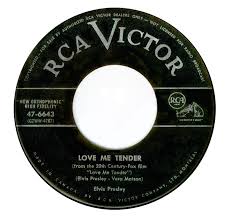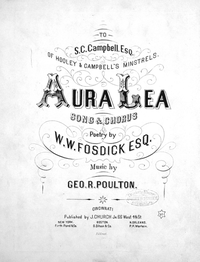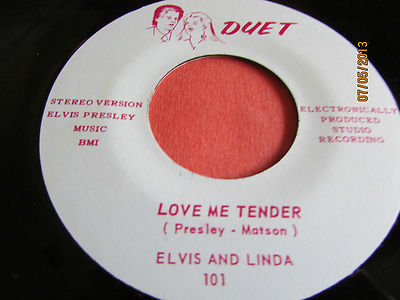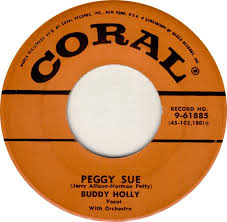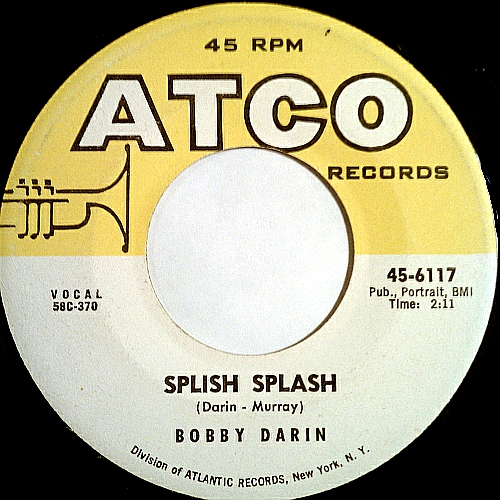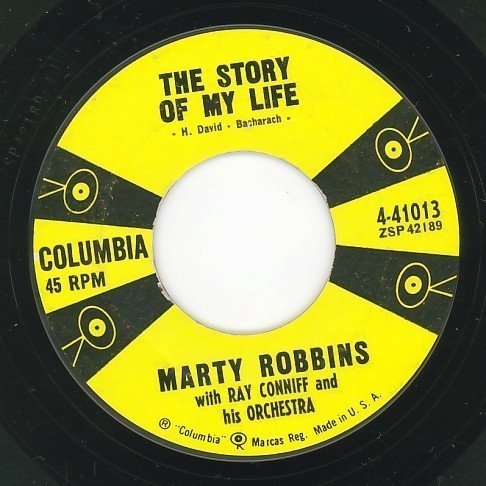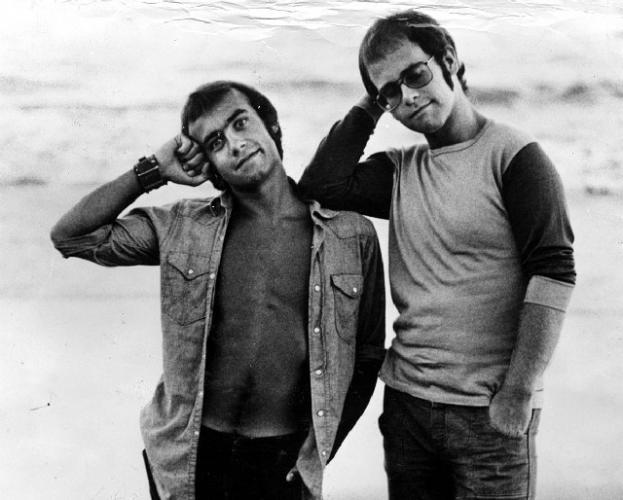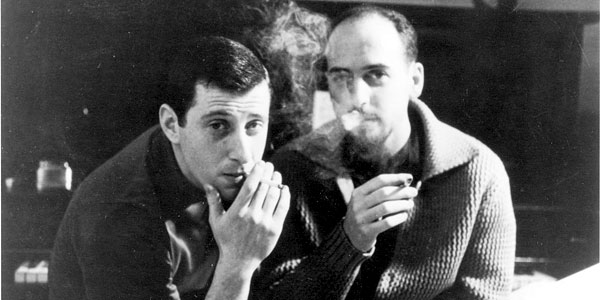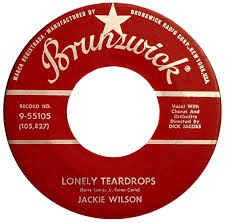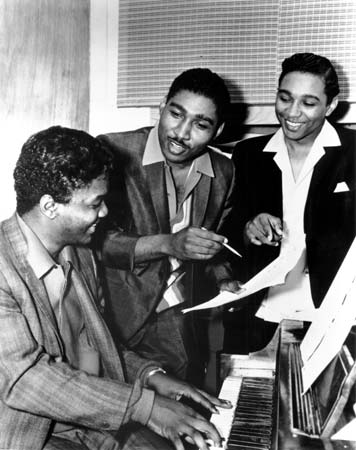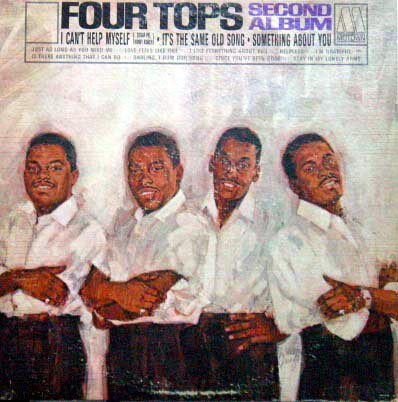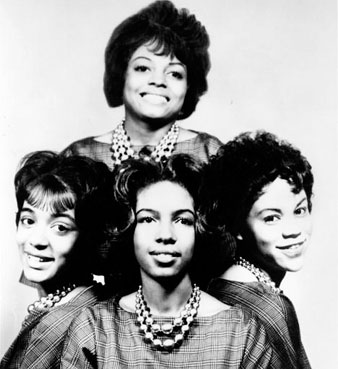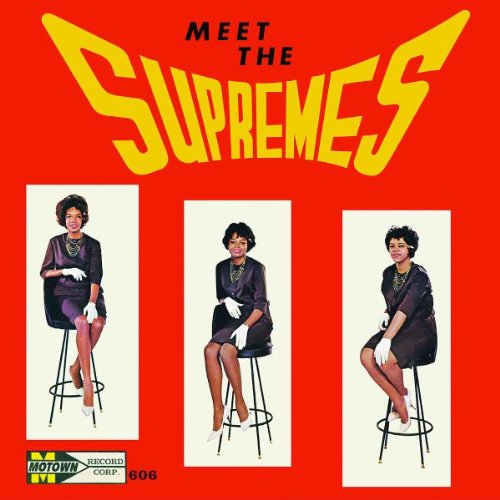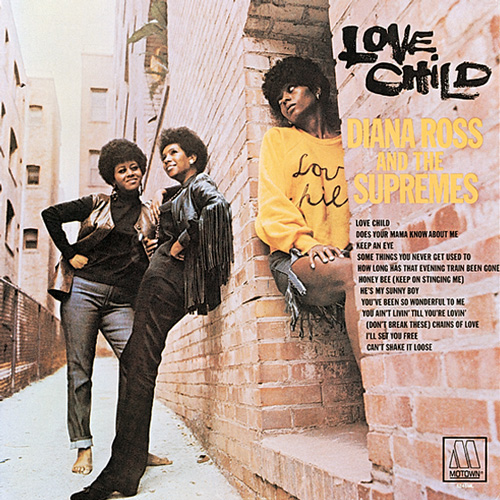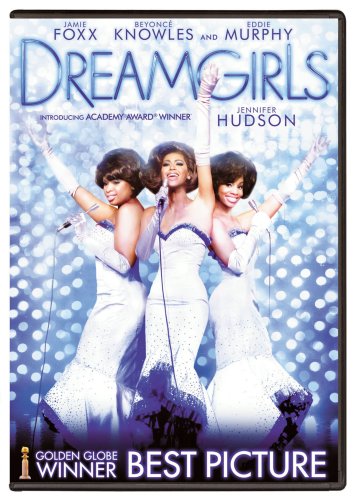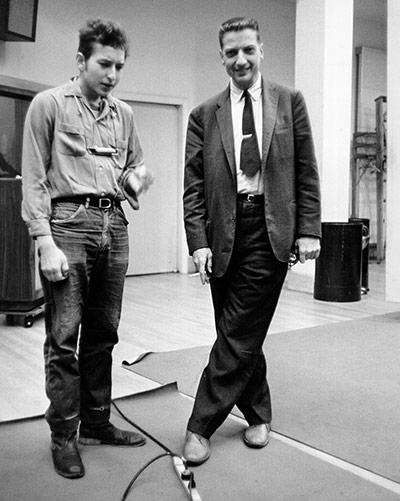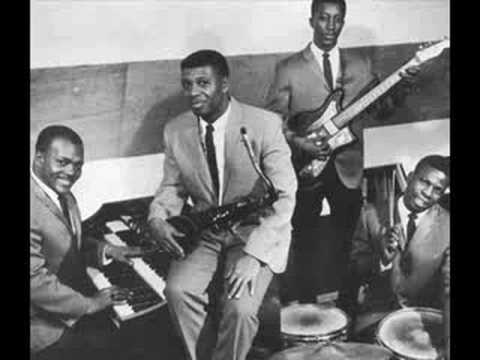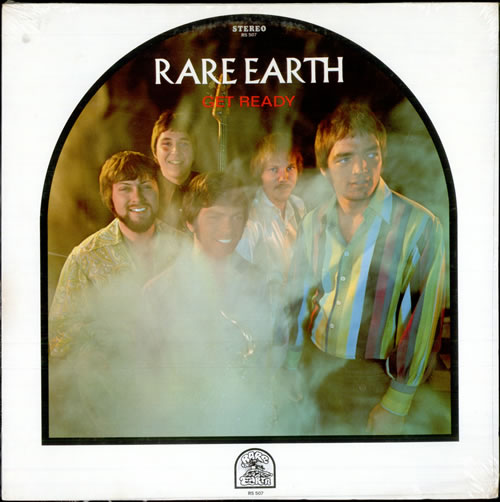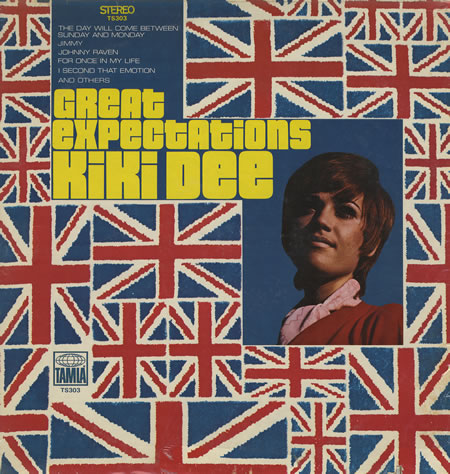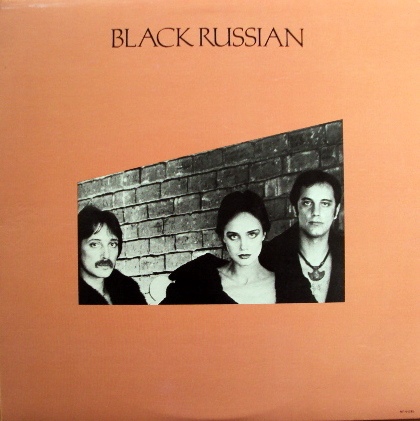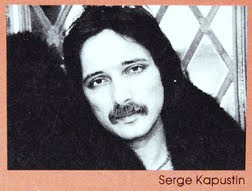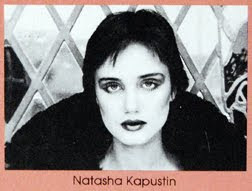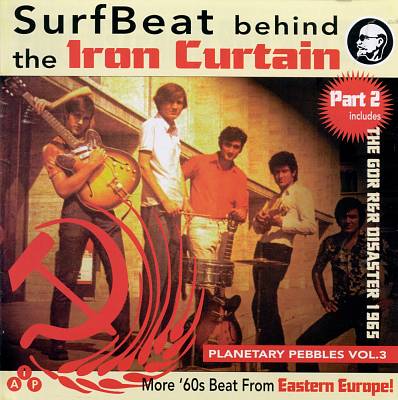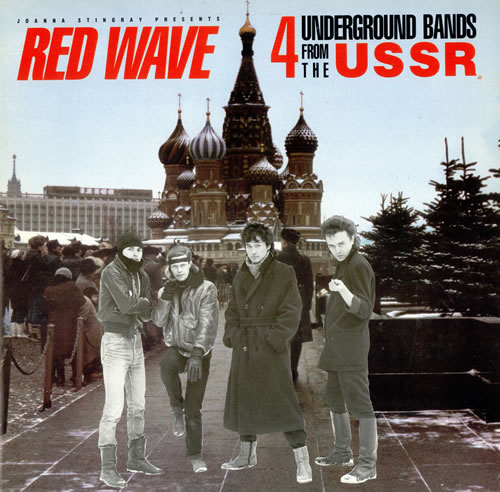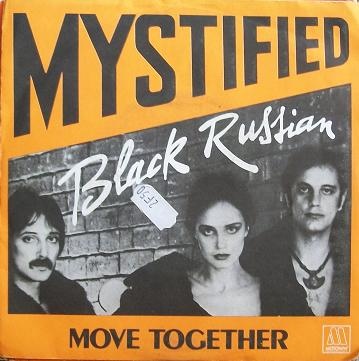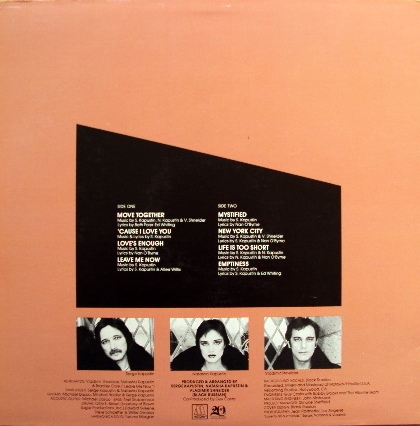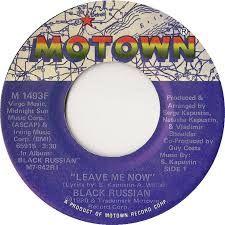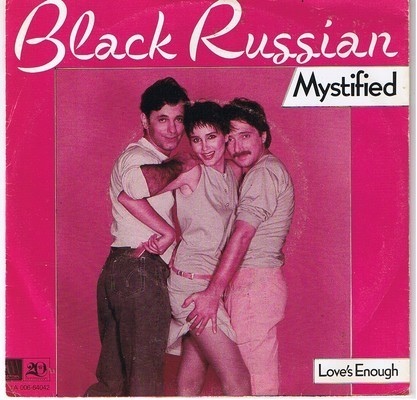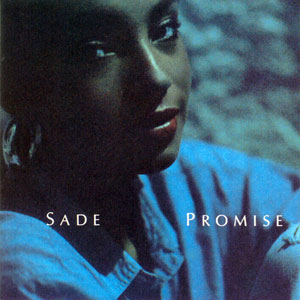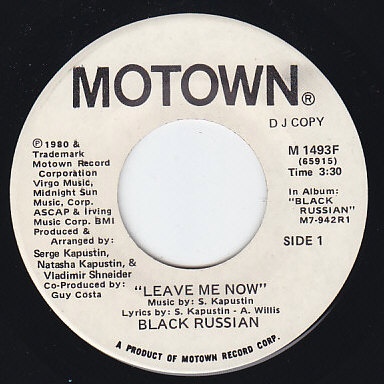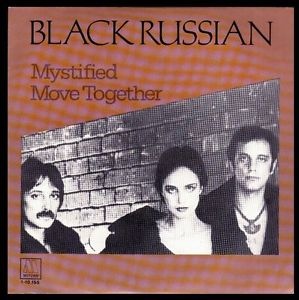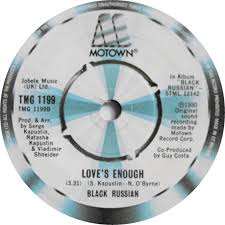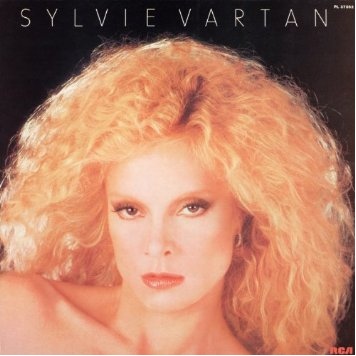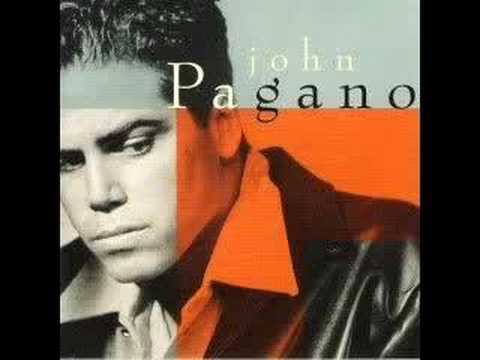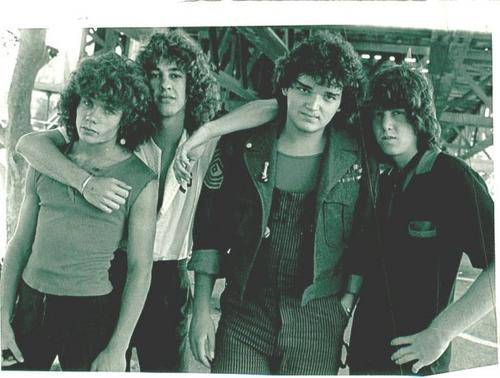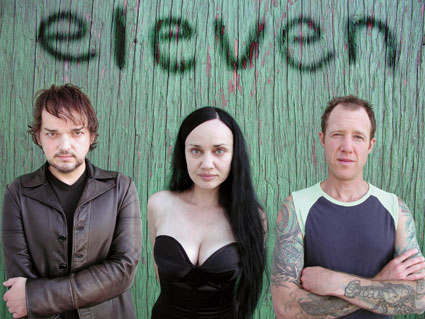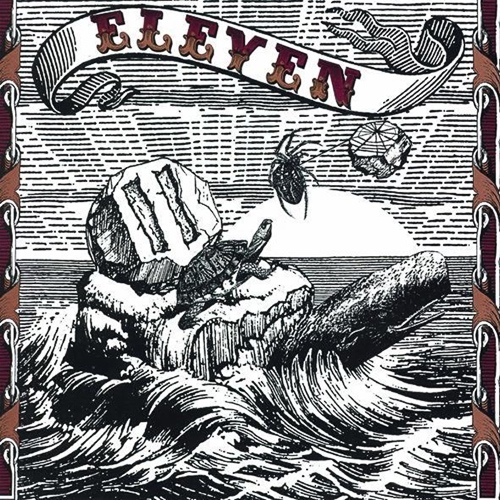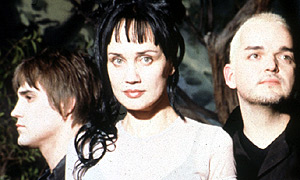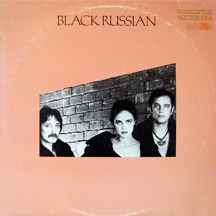 UNDER APPRECIATED ROCK BAND OF THE MONTH FOR APRIL 2015: BLACK RUSSIAN (Part 1) Speaking broadly, originally playing music and writing music were almost completely separate professions; and this division persisted until well into the 1960’s. For instance, Elvis Presley had no input on the writing of virtually all of his songs; according to Wikipedia, Elvis was actually a co-writer only on “You’ll Be Gone” and “That’s Someone You Never Forget”. If you like to check the fine print on record albums and labels like I do, this might not be immediately apparent, because songwriting credits are funny things – as long as everyone involved is in agreement (more or less), you can put down whomever you want. * * *
As an example, on Linda Ronstadt’s 1978 remake of one of the King’s signature songs, “Love Me Tender”, Elvis Presley is credited as the only songwriter on the lyric sheet. On the labels, however, and on his own 45, Elvis Presley and Vera Matson are given as the songwriters of “Love Me Tender”.
Actually, according to Wikipedia, Ken Darby was the principal songwriter of “Love Me Tender”; and Vera Matson is the maiden name of Darby’s wife. However, for a time songwriters had to concede 50% of the songwriting credit if they wanted Elvis Presley to record their song. Again, from Wikipedia: “When asked why he credited his wife as co-songwriter along with Presley, Darby responded, ‘Because she didn’t write it either’.”
* * *
As a further wrinkle, the tune for “Love Me Tender” is an adaptation of a popular Civil War-era song “Aura Lea” (published in 1861), which had music by George R. Poulton and words by W. W. Fosdick. As with most old songs, “Aura Lea” is now in the “Public Domain”, meaning that the intellectual property rights for the writing of this song have expired; thus, Poulton and Fosdick did not have to be credited at all, nor did their heirs receive any compensation when “Love Me Tender” became a big hit.
* * *
I used to hear the Elvis Presley recording of “Love Me Tender” and the Linda Ronstadt recording of “Love Me Tender” played together on the radio as though they were singing a duet of the song, and the result is simply gorgeous. Thankfully, disc jockeys have freedom in their job that others in the music industry do not, since I understood that is the only way the faux duet could be heard; because there were too many obstacles to releasing the combination as a single recording (i.e., for purchase). I did locate a photo of a disk on the Internet that does have the duet on it though; perhaps that was intended to be strictly for use by disc jockeys.
* * *
This is not to say that Elvis Presley was only a songbird – far from it. In the article on “Love Me Tender”, Wikipedia goes on to say: “As with nearly all his early RCA recordings, Presley took control in the studio despite not being credited as producer. He would regularly change arrangements and lyrics to the point the original song was barely recognizable. This, arguably, justified the co-writing credit in this case.
“Ken Darby described Elvis Presley’s role in the creation of the song: ‘He adjusted the music and the lyrics to his own particular presentation. Elvis has the most terrific ear of anyone I have ever met. He does not read music, but he does not need to. All I had to do was play the song for him once, and he made it his own! He has perfect judgment of what is right for him. He exercised that judgment when he chose “Love Me Tender” as his theme song.’”
* * *
When a young band or musician is just starting out, they would often come to the recording studio with a handful of finished songs and others that were only partially written. The more experienced record producer or arranger would then help the band flesh out the other songs and, as a result, frequently receive partial credit for having written the songs.
This was also used as a device to compensate the producer. On many of Buddy Holly’s records, their producer Norman Petty is listed as one of the songwriters; and the same is true of Robert ‘Bumps’ Blackwell on those by Little Richard.
Sometimes Buddy Holly himself isn’t credited as a songwriter; that happened with one of his best known recordings, “Peggy Sue”, but at Jerry Allison’s insistence, his name was added to the credits after his death.
* * *
Another peculiar songwriting credit has to do with Bobby Darin’s first hit song, “Splish Splash”, as I have mentioned previously. The story is that the famous New York disc jockey Murray the K (real name: Murray Kaufman) – who later helped promote the Beatles in this country and often referred to himself as the “fifth Beatle” – made a bet with Darin in 1958 that he could not write a song that started out, “Splish splash, I was takin’ a bath” – the phrase was suggested to him by his mother Jean Kaufman. Bobby Darin took the song to #3 in the nation, and it was a major boost for his career.
This was in the days of the “payola” scandals, where disc jockeys and others were secretly paid under the table to promote and play particular songs so that they would become hit records. Once a practice that was winked at, the traditional music establishment began a crusade against payola in an attempt to derail the newly popular rock and roll music, and it very nearly worked. Major figures who were caught up in the scandal included Alan Freed, one of the country’s most prominent DJ’s who played a major role in popularizing rock music (and is one of several who claimed to have coined the term “rock and roll”), and Dick Clark, though he was more cooperative in the investigations and was able to preserve his reputation (not to mention his job).
Bobby Darin wanted to give Murray the K and his mother Jean Kaufman each a songwriting credit, so they invented the name “Jean Murray”, using the first names of the DJ and his mother.
* * *
In my last post, I was mostly talking about solo songwriters like Bob Dylan and Woody Guthrie, but writing songs is primarily a collaborative profession. In many cases, the music and the lyrics would be written separately. Richard Rodgers was a towering figure in writing music for Broadway shows and other productions; he primarily worked with two different lyricists over the years, Lorenz Hart and Oscar Hammerstein II.
Burt Bacharach wrote the music, and Hal David wrote the lyrics in their collaborations; they are best known for the numerous songs that were recorded by Dionne Warwick, though their first hit was “The Story of My Life”, a 1957 song by country and western musician Marty Robbins.
* * *
The songwriting team of Elton John and Bernie Taupin came together quite by happenstance, and theirs is a nearly unique long-distance musical partnership. Altogether, they have collaborated on 30 albums.
In 1967, Elton John – then using his real name Reggie Dwight – answered an ad in the prominent British magazine New Musical Express by Ray Williams, a Liberty Records A&R man. (The initials stand for “artists and repertoire”; they are basically the people who shake the bushes looking for new talent). Bernie Taupin had answered the same ad; although neither artist was actually signed by Liberty Records, Ray Williams gave him Taupin’s telephone number.
Reggie Dwight was based in London and was then in a band called Bluesology that was backing British blues artist Long John Baldry; within six months, he started using the name Elton John as an homage to Baldry and to Elton Dean, a saxophone player in Bluesology.
Bernie Taupin though was living in Lincolnshire in eastern England. As I saw once on a television program, Taupin would send Elton John lyrics for a new song, and he would then write the music for it. The program showed the lyrics for “Tiny Dancer” that Elton had just gotten in the mail, and he mentioned some early ideas for the song and how he went about writing music. “Tiny Dancer” became a hit single and was included on Elton John’s fourth album, Madman Across the Water (1971).
Their songwriting partnership went on like this for years, and the two men were rarely in the same room together despite filling the 1970’s and 1980’s with hit songs that get a lot of radio play to this day. Elton John and Bernie Taupin both live in the Los Angeles area and see each other more frequently now.
* * *
Jerry Leiber and Mike Stoller are another legendary songwriting duo, with Leiber doing the music and Stoller writing the lyrics. They wrote rock standards like “Hound Dog” and “Kansas City”, as well as the Elvis Presley hits “Love Me”, “Jailhouse Rock”, “Loving You”, “Don’t”, and “King Creole”.
Also, most of the songs by one of my favorite 1960’s groups the Coasters were also by Leiber/Stoller. I remember seeing TV interviews by R&B singers of that period who could not believe that two Jewish boys could so perfectly capture their lives.
I heard that Jerry Leiber and Mike Stoller also led a crusade to change the copyright laws on songs. Originally, as I recall, the copyright would expire after several years and could only be renewed once. Leiber and Stoller could not understand why songs were treated the same way as, say, inventions that might have been dreamed up by just anyone.
* * *
Smokey Joe’s Café is a musical revue of early rock and roll songs that was largely based on Leiber/Stoller material; it opened on Broadway in 1995 and ran for more than 2,000 performances, making it the longest running musical revue in Broadway history. The original Broadway cast recording, Smokey Joe’s Cafe: The Songs of Leiber and Stoller won the Grammy Award in 1996 for Best Musical Show Album. Smokey Joe’s Café had a run in London also.
* * *
Happy Birthday to you Happy Birthday to you Happy Birthday dear _____________ Happy Birthday to you
That bit of doggerel is something that nearly everyone hears at least once a year. This song too has songwriting credits. As explained by Wikipedia: “According to the 1998 Guinness World Records, ‘Happy Birthday to You’ is the most recognized song in the English language, followed by ‘For He’s a Jolly Good Fellow’. The song’s base lyrics have been translated into at least 18 languages. The melody of ‘Happy Birthday to You’ comes from the song ‘Good Morning to All’, which has been attributed to American siblings Patty Hill and Mildred J. Hill in 1893, although the claim that the sisters composed the tune is disputed. Patty was a kindergarten principal in Louisville, Kentucky, developing various teaching methods at what is now the Little Loomhouse; Mildred was a pianist and composer. The sisters used ‘Good Morning to All’ as a song that young children would find easy to sing. The combination of melody and lyrics in ‘Happy Birthday to You’ first appeared in print in 1912, and probably existed even earlier.”
Despite the disputed authorship, a company called Birch Tree Group Limited locked up the songwriting credits for the song. Warner/Chappell Music bought this company for an astounding $25 million in 1988; Wikipedia states that they collected about $2,000 per day in 2008, and $700 for a single usage of “Happy Birthday to You” in one specific instance. If you ever hear that song sung in a movie, the Hills’ names will appear in the credits at the end of the movie. To this day, a toy that sings a “Happy Birthday” song will almost always be singing something besides “Happy Birthday to You”.
Wikipedia reports the latest about this song: “American law professor Robert Brauneis, who extensively researched the song, has concluded that ‘It is almost certainly no longer under copyright’. In 2013, based in large part on Brauneis’s research, Good Morning to You Productions, a documentary film company, sued Warner/Chappell for falsely claiming copyright to the song.”
* * *
Motown Records was founded in Detroit by Berry Gordy, Jr. in 1959; the original record label was Tamla Records, though Motown Records was in evidence later in the year. The label name is a contraction of “Motor Town”, reflecting the city’s status as the home of America’s largest automakers, and Motown later became a nickname for Detroit as well. (Technically the main power source in a car is an “engine”, though in the early years, everyone called it a “motor”).
Surprisingly, the Tamla Records label was named after the Debbie Reynolds song “Tammy” that was a hit from the film Tammy and the Bachelor (1957) – needless to say, “Tammy” is not at all an R&B song – and Berry Gordy originally wanted to name the label “Tammy Records”. Outside the U.S., the label was named Tamla Motown Records.
Berry Gordy’s first success as a songwriter was for a big hit for Detroit artist Jackie Wilson, “Lonely Teardrops”. He wasn’t too happy with his earnings from that song, however, so that led to the founding of the legendary record company, Motown Records.
* * *
A record company needs a songwriting team, and Motown had one of the best in the business with “Holland-Dozier-Holland”, that is, Lamont Dozier, Brian Holland and Eddie Holland (the latter two being brothers). According to Wikipedia: “During their tenure at Motown from 1962 to 1967, [Lamont] Dozier and Brian Holland were the composers and producers for each song, and Eddie Holland wrote the lyrics and arranged the vocals.”
I was frankly thrilled to see the three of them together on television once; they made a half-hearted attempt to perform one of their classic songs, but sadly not all that well – clearly their talents primarily lay elsewhere. Eddie Holland did have some early success as a recording artist though. Also, as with many if not most songwriting teams, the individuals co-wrote songs with others over the years.
* * *
Holland-Dozier-Holland is a songwriting powerhouse; besides writing some of Motown’s best-known hits, they wrote most of the songs on entire albums for some of the biggest stars on the label. For the Supremes’ second album Where Did Our Love Go (1964), not only did Holland-Dozier-Holland write the group’s three Number 1 hits that appear on the album (as well as 10 of their 12 Number 1 hits overall) – “Where Did Our Love Go”, “Baby Love”, and “Come See About Me” – they also wrote 5 of the 9 other songs on the album. About Where Did Our Love Go, Wikipedia says: “With the release of this album, the Supremes became the first act in Billboard magazine history to have three number-one hits from the same album. It was the album that introduced ‘The Motown Sound’ to the masses. It was also, at the time, the highest ranking album by an all female group.”
For the Four Tops, Four Tops Second Album (1965) included two of the group’s best known hit songs, “I Can’t Help Myself (Sugar Pie, Honey Bunch)” and “It’s The Same Old Song” that were both penned by Holland-Dozier-Holland; in all, they wrote 10 of the 12 songs on the album.
* * *
The Supremes were founded in 1959 by four teenagers – Florence Ballard, Mary Wilson, Diana Ross, and Betty McGlown – under the name the Primettes; they started as a sister act to the Primes, who evolved into the Temptations. Barbara Martin replaced McGlown in 1960. Ross was going by the name “Diane Ross” initially; that was actually the name that her mother intended to give her, but through a clerical error, her birth certificate says Diana Ross. In order to distinguish themselves from other similar groups in that era, the Primettes hired guitarist Marvin Tarplin to accompany them so they would not have to lip sync.
When Diana Ross approached Smokey Robinson (who had been a neighbor previously) about getting an audition with Motown founder Berry Gordy, Robinson agreed to help but was more impressed with their guitarist; Marvin Tarplin quickly became the guitarist for his band the Miracles for more than a decade. For his part, Berry Gordy originally thought the girls were too young and inexperienced but finally signed them in January 1961.
* * *
Interestingly, the Supremes’ little-known first album called Meet the Supremes was released in late 1962, more than a year before Meet the Beatles! came out. (Motown did the same with the debut album of the Temptations, another of their major groups, but Meet the Temptations came out two months afterward).
Some of the earliest tracks on the album date from 1960 and 1961 and feature Barbara Martin before she left to start a family in early 1962; the Supremes then went forward as a trio. Although not shown on the album cover, Martin performs background vocals on several songs and sings lead on “After All”, a song that was omitted on the original album but was included on later editions.
While the album made it to #13 on the British charts, Meet the Supremes didn’t sell well in this country; the two singles from the album, “Your Heart Belongs to Me” and “Let Me Go the Right Way” barely cracked the Billboard Hot 100, although the latter song made it to #26 on the R&B Singles chart.
All told, Motown released eight singles by the Supremes between 1961 and 1963, and none made it into the Billboard Top 40. In the Motown offices, the group was often referred to as the “No Hit Supremes”.
* * *
Early on, Florence Ballard, Mary Wilson, and Diana Ross shared lead-vocal duties on their recordings. Berry Gordy though was always impressed mainly with Diana Ross; from Wikipedia: “In Berry Gordy’s autobiography, To Be Loved, Gordy recalled he was heading to a business meeting when he heard Ross singing ‘There Goes My Baby’ and Ross’ voice ‘stopped me in my tracks’.”
Even before the name was changed to Diana Ross and the Supremes in 1967, the heavy promoting of Diana Ross was causing turmoil in the Supremes and even in other Motown groups. Florence Ballard in particular felt that she was being pushed into the background; she gained weight and began drinking heavily, eventually failing to show up for rehearsals and arriving at concerts too inebriated to perform. She was eventually eased out entirely in April 1967 and was replaced by Cindy Birdsong of Patti LaBelle and the Blue Belles. (Patti LaBelle performed on Dancing with the Stars in the current season).
Diana Ross left the Supremes in 1970 to start a solo career, though Berry Gordy had been thinking about that as early as 1966. Guinness World Records lists Diana Ross as the most successful female recording artist in history; combining her recordings with the Supremes and individually, Diana Ross has had 70 charting hit singles and sales of more than 100 million albums. In 1976, Billboard magazine named Diana Ross the “female entertainer of the century”.
* * *
The saga of the Supremes formed much of the story line for the hit musical Dreamgirls. The musical opened on Broadway in 1981 and won 6 Tony Awards. Twenty-five years later, in 2006, Dreamgirls was made into a popular film starring Jamie Foxx, Beyoncé Knowles, Eddie Murphy, and (fresh from finishing as a finalist on American Idol) Jennifer Hudson. At $80 million, Dreamgirls is the most expensive film ever to feature an all–African-American starring cast.
Dreamgirls created drama at the Oscars that year to match what was being portrayed on the screen. Despite not being nominated for Best Director or Best Picture (or any nominations for Best Actor or Best Actress either, for that matter), Dreamgirls had the most Academy Award nominations in 2007 with eight – a first at the Academy Awards. In a rare feat for an actor in a debut role, Jennifer Hudson was named Best Supporting Actress, but Eddie Murphy’s loss to Alan Arkin (for his role in the quirky and delightful comedy Little Miss Sunshine) as Best Supporting Actor was regarded as an upset. Three of the songs from Dreamgirls were nominated for Best Song, but they also lost out to the Melissa Etheridge song “I Need to Wake Up” from the Al Gore documentary film, An Inconvenient Truth.
It was a different story at the Golden Globes, where both Jennifer Hudson and Eddie Murphy won in their categories, and Dreamgirls took the award for Best Picture – Comedy or Musical; Beyoncé Knowles was also nominated for Best Actress in a Comedy or Musical.
If you ask me, the insistence on having only one category of film or performer is a major flaw at the Academy Awards, and the recent decision to multiply the nominations for Best Picture to 10 or 12 only highlights the problem. The Golden Globes is a more enjoyable television experience than the Oscars nearly every year; each Golden Globe actually means something, in contrast to the parade of technical awards that almost no one cares about that composes the middle two-thirds of the Academy Awards show.
* * *
As I wrote about Bob Dylan in my last post, his first album, Bob Dylan sold modestly; and Dylan became known as “Hammond’s Folly” around Columbia Records – John H. Hammond had decided to sign Dylan on the spot after hearing him perform on September 14, 1961 at the apartment of Carolyn Hester and Richard Fariña (two folksingers that I also wrote about last month), though he evidently made a formal audition first (no recorded evidence of that audition survives, unfortunately).
As can be seen from his example and that of Diana Ross and the Supremes, who were referred to at Motown Records early in their career as the “No Hit Supremes”, record companies give up on musicians pretty quickly; and any number of the Under Appreciated Rock Bands and Under Appreciated Rock Artists that I have written about over the years could potentially have had high-profile careers. This doesn’t seem to be true so much for, say, Hollywood actors, as many of them are able to hang around for years or even decades before making it big.
* * *
The first band signed to Motown Records was the Miracles (originally called the Matadors). The leader of this band was William “Smokey” Robinson, Jr., who was also an important songwriter and record producer who helped develop the “Motown Sound”.
Among Smokey Robinson’s own hit songs that were also his compositions (at least as a co-writer, and usually also as the song’s producer) are classics like “Shop Around” – Motown’s first million-selling hit record – plus “You’ve Really Got a Hold on Me”, “I Second That Emotion”, “Ooo Baby Baby”, “Going to a Go-Go”, “The Tracks of My Tears”, and “Tears of a Clown”. Smokey Robinson also wrote or co-wrote (as outlined in Wikipedia) “Two Lovers”, “The One Who Really Loves You”, “You Beat Me to the Punch”, and “My Guy” for Mary Wells; “The Way You Do The Things You Do”, “My Girl”, “Since I Lost My Baby”, and “Get Ready” for the Temptations; “When I’m Gone” and “Operator” for Brenda Holloway; “Don’t Mess With Bill”, “The Hunter Gets Captured by the Game”, and “My Baby Must Be a Magician” for the Marvelettes; and “I’ll Be Doggone” and “Ain’t That Peculiar” for Marvin Gaye.
* * *
One of the Motown artists that I discovered more or less by accident is Jr. Walker and the All-Stars. I knew their big hit “Shotgun” of course, but I picked up a double album called Anthology (1974) on Motown Records cheap, and it was great all the way through. Jr. Walker’s distinctive style on the saxophone drives their sound. Wikipedia says that Jr. Walker and the All-Stars is one of Motown’s “signature acts”, and I was certainly happy to discover more of that great music.
* * *
But not all of the bands and artists signed by Motown Records were African-American. Not long after I got to college, the cover of the Smokey Robinson song “Get Ready” by a band called Rare Earth was released. While they were not the first white band signed by Motown, they were the first to have a hit. Originally called the Sunliners, Rare Earth had previously released an album on Verve Records called Dreams/Answers in 1968. When they were signed by Motown Records, the company was starting a new label for white acts. The band jokingly suggested Rare Earth Records, and to their surprise, that is what Motown named the label.
“Get Ready” (which was evidently recorded live) was a million-selling record by Rare Earth that was certified gold; the extended version of this song was also one side of an album called Get Ready (1969). The other side features among its tracks two oft-covered songs on 1960’s albums, “Feeling Alright” and “Tobacco Road”.
Other hits by Rare Earth include another Motown cover, “(I Know) I’m Losing You” plus “I Just Want to Celebrate”. The latter song has recently been used in commercials for Nicoderm, a nicotine patch product, which features a miniature band performing the main chorus after a man passes on an offered cigarette.
* * *
Particularly in the 1970’s, Motown Records began signing a more wide-ranging group of musical acts. Many were established artists from years past, such as Frankie Valli and the Four Seasons, Bobby Darin, “twang” guitarist Duane Eddy, and the Easybeats (an Australian band who had had a worldwide hit in 1966 with “Friday on My Mind”). Like Rare Earth though, most were new to the music scene, such as Kiki Dee; she was the first female artist from England that was signed to Motown Records, though Kiki Dee had better success with Elton John’s label Rocket Records, including the 1974 hit “I’ve Got the Music in Me” and her well-known duet with Elton John on the 1976 hit “Don’t Go Breaking My Heart”.
Before releasing his monster hit album in 1971 called Bat out of Hell, Meat Loaf was in a duo called Stoney & Meatloaf that was signed by Motown the year before. Others include Crystal Mansion (a white psychedelic/R&B band that is a future UARB), Toe Fat (a British band that included two future members of Uriah Heep), Love Sculpture (a Welsh blues-rock band that was led by Dave Edmunds), and a Dutch band called the Cats.
* * *
This month’s Under Appreciated Rock Band of the Month, BLACK RUSSIAN became the first recording artist from the Soviet Union to be signed to a major American record label, in this case, Motown Records. Their sole album, Black Russian came out in 1980 on Motown Records – evidently the label had decided that there was no reason to segregate their white acts any longer.
Bandmembers in Black Russian were Serge Kapustin and Natasha Kapustin, a married couple, along with Natasha’s brother Vladimir Shneider. The two Shneiders were the children of folk musicians and had been trained as classical pianists. Although identified as Russian, they were actually born in Latvia, a separate country now. In 1973 at an underground rock gathering at Moscow University, Natasha Shneider met Serge Kapustin, the son of a radio broadcaster, and he joined her in the Soviet orchestra where she was employed. The three began making plans to emigrate to America as early as May of that year.
They had been successful musicians in the U.S.S.R. but were worn down by the capricious restrictions of the Communist establishment. Serge Kapustin said that he was once forced to take out a bass line in one of their songs because it sounded “too Western”, and not more than one fourth of their songs could typically be sung in English.
* * *
One might think that the name Black Russian naturally arose from a Russian band being signed to a black record label, and there is also a drink called a Black Russian, composed of vodka mingled with coffee liqueur; but it wasn’t really like that. In an Associated Press interview that was printed in the London newspaper The Daily Telegraph, Natasha Kapustin said: “It means we are black Russians, not red Russians. And we were black sheep.” Serge Kapustin added: “And there is our influence from black rhythm ’n’ blues and soul music. ‘Black Russian’ became our nickname in underground circles in Moscow.”
* * *
As quoted in the blog What Fresh Hell is This (overall the best source on information on Black Russian that I was able to find on the Internet), People magazine said of the group in their October 16, 1980 issue: “The Kapustins were members of Sovremennik, a state-run pop orchestra, with Natasha [Kapustin] on vocals and piano and Serge [Kapustin] on guitar and percussion. Vladimir [Shneider] produced and played piano for the Singing Hearts, which was one of Russia’s hottest groups in the mid-’70s. But, as Vladimir notes, they were pumping out more agitprop than pop. ‘We’d sing 37 songs about how good the Communist Party is, and at the end — if we were lucky — we were allowed to play a mellow song like ‘Killing Me Softly’ or ‘Ain’t No Sunshine’. But never rock.”
* * *
The People magazine article ends with a proposal by Serge Kapustin of Black Russian: “Just put 100 rock ’n’ roll radio stations along the Soviet border. You’d kill off Russian Communism — snap — just like that.”
As I am sure I have said before in these posts, IMHO the growing prominence of rock music in the Soviet Union, and the sense of freedom that kind of music engenders is a big part of why the Iron Curtain fell. Maybe something like that can happen in the Middle East also, if the younger generation tires of the way everyone is living over there now.
* * *
The Communists could not keep rock and roll out of the country entirely; Natasha Kapustin of Black Russian recalls: “Even though Western music was condemned in Russia, we knew what was happening in the world. We listened to the Voice of America broadcasts, the major European radio stations and got records from our Western friends or bought records on the black market. I can still remember the day Jimi Hendrix died because there were black armbands all over Moscow.”
I have two delightful albums in my collection entitled Surfbeat Behind the Iron Curtain that were released several years ago by AIP Records. They feature mostly instrumental recordings made by Russian and Eastern European bands that were evidently officially sanctioned by the Communist governments. The small number of these recordings made it necessary for the label to create a faux “battle of the bands” between these groups and similar sounds produced by Western bands of the same time period. The music is actually quite good though fairly tame.
* * *
It didn’t stay that way though; harder rocking Russian rock bands began releasing albums more openly by the 1980’s, and some were available in this country as well. The above double-LP album, Red Wave (1986) featured an album side each of music from four hard rock bands from Leningrad: Akvarium (“Aquarium”), Strannye Igry (“Strange Games”), Alisa, and Kino (“Cinema”). At one of the three World’s Fairs that we went to in the 1980’s – probably the Expo 86 in Vancouver, B.C. – the pavilion for the Soviet Union had a section where some of this rock music could be heard.
With the success of this album, Russian rock bands were able to tour in other countries, and Western rock bands began playing concerts in Russia as well. As I have noted in an earlier post, Uriah Heep was the first, in 1987, followed by the German band Scorpions in 1988.
* * *
Serge Kapustin, Natasha Kapustin and Vladimir Shneider of Black Russian were dissident Russian Jews who defected in May 1976 and came to New York City. They eventually saved enough to go to Hollywood where they auditioned for Berry Gordy at Motown Records. People magazine notes that this delay in their success in this country was just as well: “The group couldn’t go public with its fascinating story until six additional family members arrived safely in the U.S.”
* * *
What Fresh Hell is This quotes this item in the June 14. 1980 issue of Billboard Magazine about Black Russian: “Actually from the U.S.S.R., Black Russian is a pop trio which makes crystalline pop/r&b that comes across as a more r&b-oriented ABBA. Natasha Kapustin has an excellent soaring voice. ‘Leave Me Now’ really gives her room to show off her vocal strength. The production is exceptionally clean with Vladimir Shneider’s keyboard and the synthesizers of Serge [Kapustin] and Natasha Kapustin lending a cushy sheen. The album is evenly divided between uptempo dance cuts and moody ballads. Best cuts: ‘Mystified’, ‘Leave Me Now’, ‘Emptiness’, ‘New York City’, ‘Love’s Enough’.”
* * *
Actually the song that has been running through my head most of the times I played Black Russian is “’Cause I Love You”. Black Russian are professionals who put their heart and soul into this album. The music stacks up well with the other albums of that era, and truly, “Mystified” should have been a hit single. As with most of the UARB’s and UARA’s that I write about, I love the whole album, and it is difficult for me to single out particular songs. My personal favorite though would have to be “Leave Me Now”, a plaintive ballad that is as compelling as any that I can remember from the 1980’s.
* * *
Although there is nothing about Black Russian in Wikipedia, there is a Wikipedia article about Natasha Shneider that has some information about Black Russian; Wikipedia as well has a write-up about the hard rock band Eleven that included Natasha Shneider and her second husband Alain Johannes. Allmusic lists Black Russian but has no information at all about the album or the artist.
Most of the posts that I found on the Internet seem more interested in the Black Russian story than in the music. Writing for Orange Coast magazine of Orange County, California, Keith Tuber stated in an article entitled “Black Russians Mix Well Socially”: “The problem with the album, which is musically interesting and contains an assortment of classical chord structures – a manifestation of the trio’s early training – is the lyrics. Only ‘’Cause I Love You’ is entirely written by one of the bandmembers (Serge [Kapustin]), while the others are collaborations. To my mind, the words are vastly inferior to the music.”
Along with links to two of the songs, “Move Together” and “’Cause I Love You”, the blog called The Homoerratic Radio Show says of the album: “Unfortunately, most of their songs sound like numbers cut from the final version of a mediocre Broadway musical. Still, the group’s got an interesting story, and these two songs aren’t that bad.”
* * *
Not everyone feels that way though. Doc Dosco, a jazz guitarist who played on Black Russian wrote of his early session work on his website www.docdosco.com: “‘I did tons of “guitar for hire” studio dates back then’, says Doc, ‘and I gigged a lot during the late seventies and eighties. I was a funky fusion style player and there was lots of funk style work. I also did pick-up work, casuals, society gigs and played numerous concerts with old timers such as Little Anthony, the Drifters, the Diamonds, the Platters, Freddy Cannon, Connie Stevens. I worked for composer Dennis McCarthy on the Barbara Mandrell [and the Mandrell Sisters] TV show. I also wrote songs for Jerry Lee Lewis and German pop sensation Nina Hagen, produced “Billboard Queen” Angelyne, and recorded an album with the revolutionary Motown recording artists Black Russian.’”
* * *
When thinking about Black Russian, I am reminded of a review of one of Sade’s albums in the Village Voice (maybe Promise) that I have been unable to find online. The reviewer noted that the album sounds like music that you have heard before, but you actually haven’t. I can imagine that one or two casual listens to Black Russian could lead to the opinions given above – particularly if one is predisposed to dissing anything that even hints of disco – but to these ears, this music represents brilliant songmaking that combines an appreciation of older R&B music with what was happening in the modern scene. It might be my imagination, but sonically, Black Russian seems louder than most of the other albums that I have been playing recently.
I once wrote about Patti Smith in another connection that she “sounds like nothing so much as the Beat poets of the 1950’s”. Despite their groundbreaking sound, Annie Lennox’s vocals for Eurythmics – who came onto the music scene at about the same time as Black Russian – sounded like a 1940’s chanteuse to me. Similarly, Black Russian is a startling album from the very beginning of the lively decade of the 1980’s whose source is from a decade or two earlier. In 2015, the album is not a bit passé but still sounds as fresh as it must have the day it was released; today, the album gives the listener a double dose of looking back.
* * *
Two singles were released from the Black Russian album, “Leave Me Now” and “Mystified”. In addition to the U.S., the album was released in Canada, the UK, the Netherlands, France, and Spain; and the “Mystified” single was also released in those European counties. According to a blog post that I saw, Black Russian made an appearance on the Dinah Shore Show.
Despite the novelty of being able to hear Russian music and the thawing of relations with the Soviet Union – “Détente” had begun around 1969 – sales of the album and singles alike were poor. I have long since given up trying to figure out why some songs are hits, and others are not.
* * *
The songs by Black Russian are all in English, with Natasha Kapustin handling most of the vocals; they have something of a disco-lite vibe in keeping with the time period. The bandmembers wrote all of the music and also produced and arranged all of the songs on the album. Besides vocals, Serge Kapustin plays keyboards and guitar, Natasha Kapustin plays keyboards and synthesizers, and Vladimir Shneider plays synthesizers. Another eight musicians are listed on the credits at Discogs; Guy Costa – their first contact at Motown Records – is identified as co-producer.
* * *
Black Russian had some assistance with the lyrics, perhaps because English is not their native language; they hardly spoke the language at all at the time that they defected. Lyricists who lent a hand include Allee Willis, who co-wrote the lyrics for their beautiful first single “Leave Me Now”. Willis has had a long career as a writer, songwriter, set designer, and artist. Her musical credits are as wide-ranging as can be imagined; together with Stephen Bray and Brenda Russell, Allee Willis wrote the music for the 2005 Broadway musical The Color Purple, based on the 1982 novel, The Color Purple by Alice Walker and the 1985 movie, The Color Purple that was directed by Steven Spielberg and starred Whoopi Goldberg, Oprah Winfrey, Danny Glover, and Rae Dawn Chong. Allee Willis was also one of the writers of the song by the Rembrandts, “I’ll be There for You” that was the theme song for the massively popular sitcom Friends and one of the best selling TV theme songs of all time. Willis won a Grammy Award in 1985 for Best Soundtrack for Beverly Hills Cop.
From Wikipedia: “[Allee Willis]’ songs have sold over 50,000,000 records, including ‘September’ and ‘Boogie Wonderland’ by Earth, Wind and Fire, ‘Neutron Dance’ by the Pointer Sisters, ‘What Have I Done to Deserve This?’ by Pet Shop Boys with Dusty Springfield, and ‘Lead Me On’ by Maxine Nightingale. Willis has collaborated with hundreds of leading artists and composers from all fields of music, including Bob Dylan, Patti LaBelle, James Brown, Herbie Hancock, Deniece Williams, and Motown legend Lamont Dozier.”
* * *
Nan O’Byrne wrote the lyrics for Black Russian’s second single “Mystified” and the flip side of the first single, “Love’s Enough”; and she co-wrote the lyrics for two other songs on the album. Nan O’Byrne also co-wrote “You Might Need Somebody” that was a UK hit for Randy Crawford in 1981, and “You Might Need Somebody” was later a hit for Shola Ama in 1997; “You Might Need Somebody” was first recorded by Turley Richards in 1980, and “You Might Need Somebody” was also covered by Joe Walsh. Nan O’Byrne’s songs have been recorded by Earth, Wind and Fire, the Pointer Sisters, Weather Report, Bonnie Raitt, and Philip Bailey.
Ed Whiting and Beth Forer wrote the lyrics for another Black Russian song, “Move Together”.
* * *
Shortly after Black Russian broke up, Serge Kapustin and Nan O’Byrne worked with French singer and actress Sylvie Vartan, who is of Bulgarian-Armenian ancestry. In the 1960’s, Sylvie Vartan was one of the top performers in France; from Wikipedia: “She is known as one of the most productive and tough-sounding yé-yé artists. Her performances often featured elaborate show-dance choreography, and she made many appearances on French and Italian TV.” The term “yé-yé” is derived from the “yeah yeah” calls that were popularized by the Beatles and other 1960’s bands; many if not most of the performers were women, so they became known as “yé-yé girls”.
After touring with him and making a movie together, Sylvie Vartan married Johnny Hallyday, a true French icon who is often referred to as the “French Elvis” and has sold 80 million albums worldwide (though he remains largely unknown in the English-speaking world). They flew to Nashville by the end of 1963 and recorded a best-selling album with the Jordanaires (who recorded with the real Elvis for many years) called Sylvie à Nashville; it sold one million copies in Japan alone. Three of the songs were in English, including one with Paul Anka. Sylvie Vartan and Johnny Hallyday were the country’s “golden couple” and had joint sellout shows annually in the 1960’s through the 1970’s.
Shortly after Sylvie Vartan and Johnny Hallyday divorced in late 1980, Serge Kapustin and Nan O’Byrne collaborated on a song called “Il Me Fait De La Magie” (“It Reminds Me of the Magic”) with French singer Marie-José Casanova. The song appeared on the French album Sylvie Vartan by Sylvie Vartan that was evidently intended to re-establish her identity as a singer. The album is one of several eponymous albums listed in the Discogs site, but in the extensive “List of Sylvie Vartan albums” in Wikipedia, the album is apparently the one also listed as Ça Va Mal (the opening track on Sylvie Vartan is “Ça Va Mal”). The album was reissued on CD in 2013.
* * *
I did not find anything else going on with Serge Kapustin of Black Russian until recent times, when he worked on several recordings with singer John Pagano. Pagano is from Rhode Island and combines R&B and easy-listening stylings; he is best known as the long-time lead vocalist in Burt Bacharach’s touring band. Three songs are available at several Internet sites by the pair: “Destiny”, “Hope”, and “A Time in Space”.
As to Vladimir Shneider, there are numerous books published by an author of that name, but I am not sure he is the same one who was in Black Russian.
* * *
Within a few more years, Serge Kapustin and Natasha Kapustin divorced, with the latter regaining her maiden name Natasha Shneider. Most of her post-Black Russian work was with her musical partner and second husband, Alain Johannes; he is also from far away, having been born in Santiago, Chile. Natasha Shneider was in a well regarded band called Eleven along with Johannes and top drummer Jack Irons.
Jack Irons and Alain Johannes were part of the coterie where the band Red Hot Chili Peppers was born. RHCP founding members Hillel Slovak (guitar) and Jack Irons (drums) were in a high school band in Los Angeles that was eventually called What Is This?, along with Alain Johannes (vocals) and Todd Strassman (bass). (The name is taken from the reaction they noticed by many people when they heard the band). A third founding member of RHCP, Michael Balzary, better known as Flea was the bassist in What Is This? for a time, but he later joined the punk rock band Fear (and began making numerous appearances as an actor); also, Anthony Kiedis was serving as a roadie and “hype-man” for What Is This?.
* * *
In 1983, Hillel Slovak, Jack Irons, Flea, and Anthony Kiedis came together for what was intended to be a one-time, loose performance at the Rhythm Lounge, billed as Tony Flow and the Majestic Masters of Mayhem. Although only about 30 people were in attendance, the show was so well received that they returned the following week and eventually put together a six-song demo tape under their new name Red Hot Chili Peppers.
Over a period of time, and following multiple changes in personnel, Red Hot Chili Peppers became a very big deal; and they have sold 80 million albums worldwide, with their fifth album Blood Sugar Sex Magik (1991) being their commercial breakthrough. However, neither Hillel Slovak nor Jack Irons played on their debut album, The Red Hot Chili Peppers (1984). I am used to going to concerts where most of the people there are a lot younger than I am, but I have never felt so out of place as the night we went to see Red Hot Chili Peppers in New York.
* * *
Meanwhile, Hillel Slovak and Jack Irons were still members of What Is This?; Slovak in particular was not initially ready to cast his lot with Red Hot Chili Peppers. What Is This? was signed with MCA Records at about the same time that Red Hot Chili Peppers was jointly signed by EMI America Records and Enigma Records. The debut EP by What Is This?, Squeezed was released in 1984, with Chris Hutchinson playing bass; after that, Hillel Slovak went back to Red Hot Chili Peppers and played on their next two albums.
In the following year, What Is This? released their only full-length album, What Is This? plus a live EP, 3 out of 5 Live. After that, What Is This? broke up, and Jack Irons returned to Red Hot Chili Peppers also. According to Wikipedia, the band’s third album, The Uplift Mofo Party Plan (1987) is the only Red Hot Chili Peppers album to feature all four original members – Hillel Slovak, Jack Irons, Flea and Anthony Kiedis – on each track.
* * *
While What Is This? was working on their album, Alain Johannes met Natasha Shneider, and they immediately clicked musically. She joined What Is This? shortly thereafter. They then formed a duo called Walk the Moon – not the same band as the Cincinnati-based band Walk the Moon that formed in 2006 – and had other musical sounds besides rock on their album, Walk the Moon (1987). Jack Irons and Chris Hutchinson evidently played on several of the tracks, but on many, they used drum machines.
In an interview posted on ultimate-guitar.com, Alain Johannes discussed the album: “We [Alain Johannes and Natasha Shneider] became Walk the Moon and started to explore more of the songwriting stuff and different textures that are not usually rock band-based like synths and all that other stuff and I started playing my odd instruments. Well, some of them not odd but the pipa [Chinese lute] or sing like a Sufi-inspired Kowali singing and Natasha would do little choirs.”
* * *
The two are better known for their work with Eleven, a hard rock trio that formed in 1990 when Jack Irons (drums) joined Alain Johannes (vocals, guitar, sitar, horns) and Natasha Shneider (vocals, keyboards, bass) of Walk the Moon; this band was also a partial reunion of What Is This?. Eleven have opened for major bands like Pearl Jam, Soundgarden, Queens of the Stone Age, and Candlebox.
Wikipedia states: “The band [Eleven] cites their major influences as Jimmy Page and Led Zeppelin, Queen, The Beatles, Johann Sebastian Bach, and Sergei Prokofiev. With Chris Cornell [of Soundgarden and Audioslave], they recorded [Natasha] Shneider’s arrangement of Franz Schubert’s ‘Ave Maria’, which appears on the album, A Very Special Christmas 3 [1997], in the liner notes of which they state they deliberately chose a classical work to help interest young people in classical music.”
* * *
Their opening album, Awake in a Dream (1991) was praised by Alex Henderson in Allmusic: “Eleven was a so-called alternative rock trio of the early 1990’s that drew heavily on the psychedelic rock and soul music of the late 1960’s and early 1970’s. Awake in a Dream is much too guitar-oriented to have been played on a Black radio station in 1970 or 1973, and yet, enjoyable selections like ‘Before Your Eyes’, ‘All Together’ and ‘Rainbow’s End’ make it clear that singer/guitarist Alain Johannes, bassist/singer/organist Natasha Shneider and drummer Jack Irons have spent a lot of time listening to the likes of Sly and the Family Stone, Ike and Tina Turner and Stevie Wonder. Shneider is also heard on the clavinet, a synthesizer that was prominent in 1970’s soul and funk but was seldom used in the urban contemporary music that followed in the 1980’s and 1990’s.”
Of their second album Eleven, Andy Hinds wrote for Allmusic: “Anyone who lumped Eleven in with the grunge glut of the early 1990’s simply wasn’t paying attention. Although it’s true that the trio’s excellent self-titled album (actually their second) was mixed with the guitars loud and fuzzy, the musical sophistication that distinguishes Eleven – including not only compositional prowess but sheer chops – leaves most alternative bands in the dust. Led by the husband/wife duo of Alain Johannes (guitars and lead vocals) and Natasha Shneider (keyboards and lead vocals), their primary calling card is a pair of extraordinary voices, both of which are capable of raw intensity and soulful understatement.”
With Queens of the Stone Age stalwart Josh Homme providing lead vocals, Eleven recorded the song “Stone Cold Crazy” for the album, Killer Queen: A Tribute To Queen (2005).
* * *
Jack Irons left Eleven after their second album to play drums for Pearl Jam but later returned to the band. Both Alain Johannes and Natasha Shneider were involved in Jack Irons’ solo album, Attention Dimension (2004); Shneider played electric bass and piano on “Hearing it Doubled” and keyboards on Jack Irons’ cover of the Pink Floyd song “Shine on, You Crazy Diamond”.
* * *
For Part 2 of this post, go to: Black Russian (Part 2).
* * * The Honor Roll of the Under Appreciated Rock Bands and Artists follows, in date order, including a link to the original Facebook posts and the theme of the article.
(Year 10 Review) |
Home > Original Facebook Posts >
Original Facebook Post / Apr 2015 / BLACK RUSSIAN Part 1
 UNDER APPRECIATED ROCK BAND OF THE MONTH FOR APRIL 2015: BLACK RUSSIAN (Part 1) Speaking broadly, originally playing music and writing music were almost completely separate professions; and this division persisted until well into the 1960’s. For instance, Elvis Presley had no input on the writing of virtually all of his songs; according to Wikipedia, Elvis was actually a co-writer only on “You’ll Be Gone” and “That’s Someone You Never Forget”. If you like to check the fine print on record albums and labels like I do, this might not be immediately apparent, because songwriting credits are funny things – as long as everyone involved is in agreement (more or less), you can put down whomever you want. * * * |
